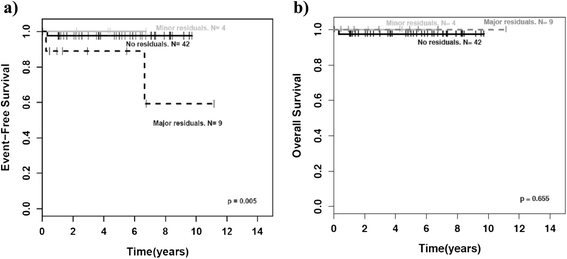Treatment and outcome of Ganglioneuroma and Ganglioneuroblastoma intermixed
- PMID: 27465021
- PMCID: PMC4964292
- DOI: 10.1186/s12885-016-2513-9
Treatment and outcome of Ganglioneuroma and Ganglioneuroblastoma intermixed
Abstract
Background: Ganglioneuroma (GN) and ganglioneuroblastoma intermixed (GNBI) are mature variants of neuroblastic tumors (NT). It is still discussed whether incomplete resection of GN/GNBI impairs the outcome of patients.
Methods: Clinical characteristics and outcome of localized GN/GNBI were retrospectively compared to localized neuroblastoma (NB) and ganglioneuroblastoma-nodular (GNBN) registered in the German neuroblastoma trials between 2000 and 2010.
Results: Of 808 consecutive localized NT, 162 (20 %) were classified as GN and 55 (7 %) as GNBI. GN/GNBI patients presented more often with stage 1 disease (68 % vs. 37 %, p < 0.001), less frequently with adrenal tumors (31 % vs. 43 %, p = 0.001) and positive mIBG-uptake (34 % vs. 90 %, p < 0.001), and had less often elevated urine catecholamine metabolites (homovanillic acid 39 % vs. 62 %, p < 0.001, vanillylmandelic acid 27 % vs. 64 %, p < 0.001). Median age at diagnosis increased with grade of differentiation (NB/GNBN: 9; GNBI: 61; GN-maturing: 71; GN-mature: 125 months, p < 0.001). Complete tumor resection was achieved at diagnosis in 70 % of 162 GN and 67 % of 55 GNBI, and after 4 to 32 months of observation in 4 GN (2 %) and 5 GNBI (9 %). Eleven patients received chemotherapy without substantial effect. Fifty-five residual tumors (42 GN, 13 GNBI) are currently under observation (median: 44 months). Five patients (3 GN, 2 GNBI) showed local progression; all had tumor residuals > 2 cm. No progression occurred after subtotal resection. Two patients died of treatment, none of tumor progression.
Conclusions: GN/GNBI account for one quarter of localized NT and differ from immature tumors in their clinical features. Chemotherapy is not effective. Subtotal resection appears to be a sufficient treatment.
Trial registration: ClinicalTrials.gov identifiers - NB97 (NCT00017225; registered June 6, 2001); NB2004 (NCT00410631; registered December 11, 2006).
Keywords: Ganglioneuroblastoma intermixed; Ganglioneuroma; Residual tumor; Subtotal resection; Surgery; Therapy; Treatment.
Figures






References
-
- Kaatsch P. Epidemiology of childhood cancer. Cancer Treat Rev. 2010. doi:10.1016/j.ctrv.2010.02.003 - PubMed
-
- Shimada H, Ambros IM, Dehner LP, Hata J, Joshi VV, Roald B. Terminology and morphologic criteria of neuroblastic tumors: recommendations by the International Neuroblastoma Pathology Committee. Cancer. 1999;86(2):349–63. doi: 10.1002/(SICI)1097-0142(19990715)86:2<349::AID-CNCR20>3.0.CO;2-Y. - DOI - PubMed
Publication types
MeSH terms
Associated data
LinkOut - more resources
Full Text Sources
Other Literature Sources
Medical
Research Materials

